I first encountered the term when Allan Savory rubbed our noses in it at Montana State University in 1978.
He also forcefully clarified the actual meaning of “overgrazing.” He was not a subtle guest lecturer.
So what exactly is stock density? It’s the number of grazing animals per unit area at any moment in time, usually expressed as the number per acre (animal units per acre, or AU/A).
It’s a feature of all of the “intensive” grazing systems, such as time control, short duration, mob, MIG and others. I believe it to be one of the keys to efficient forage use and sound grazing management.
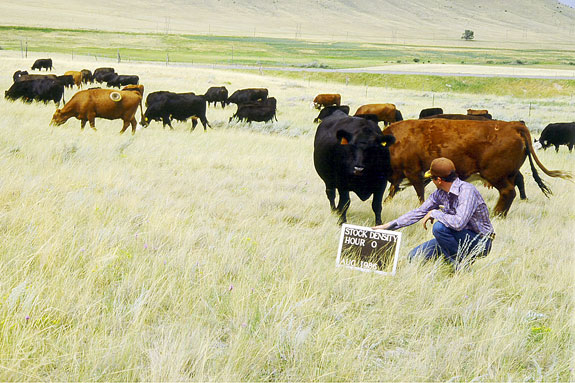
While at Montana State, I conducted research using 30 cow/calf pairs per acre in spring and fall grazing trials.
In addition to high-density grazing programs for cattle, I also designed and implemented a grazing program for 2,650 head of Montana bison using high stock densities. There was much to learn from these endeavors.
Stock density in most western U.S. ranching situations is typically very low, as in one animal per 10 acres (0.1 AU/A).
In some of the intensive grazing systems, stock densities of 10 to 30-plus AU/A are not uncommon.
This constitutes a huge difference in the way grazing occurs and in its impacts on the soils and vegetation.
How and why is stock density such a valuable tool in achieving range health and production goals? How does it affect soils and vegetation and how does it affect livestock? This article is intended to answer some of these questions.
Traditional grazing management with low stock densities only controls:
- How many livestock are in a pasture
- When livestock go in a pasture
- When livestock go off the pasture
Thus, when livestock are in a pasture they choose where they go and what they prefer to graze. That is, unless we use the tool of stock density.
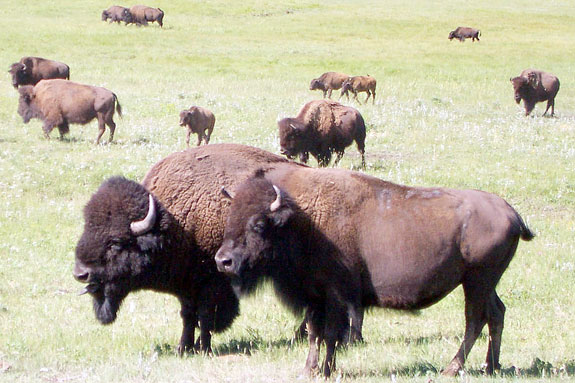
Stock density becomes an active tool at densities as low as 1 AU/A and especially at densities above 10 to 20 AU/A.
At higher stock densities, animals necessarily distribute themselves throughout a grazing unit to access forage – they eat forage they may not prefer and their impacts to soils are increased with their trampling, dunging and urinating (not a bad thing).
Let’s briefly consider the role grazing can play in forage plant mortality.
Kinds of grazing that damage or kill forage plants:
- Amount of forage removed – overutilization
- Time when forage is removed – season of use
- Number of times grazed – grazing frequency
- Length of time between defoliations (grazing interval) – overgrazing
- Non-use and consequent stagnation – over-resting
Stock density is the one tool that can help the grazing manager avoid most of these threats to forage plants. Here’s an example of how overgrazing and over-resting can be avoided:
An example of stock density in action
Contrast the grazing management strategies of two ranch managers regarding the same ranching property. In each case, 2,000 acres of range are available from June 15 to Oct. 1 (3.5 months).
A stream runs through the long axis of a valley, with timbered uplands on one side (see figures).
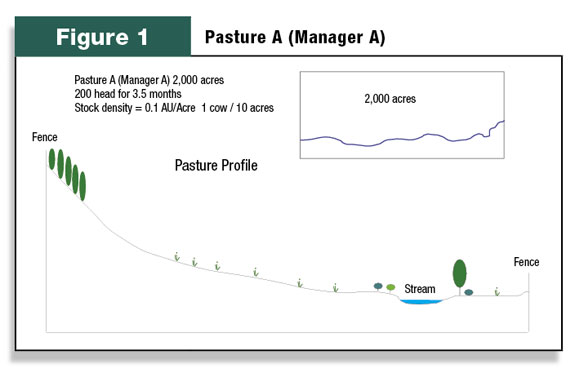
Manager A grazing plan
- 2,000 acres, 200 cows, 1 pasture
- Stocked at 3 acres per AUM
- Stock density = 2,000/200 = 0.1 AU/acre, i.e. each cow has 10 acres
- Grazing period is 3.5 months (about 100 days)
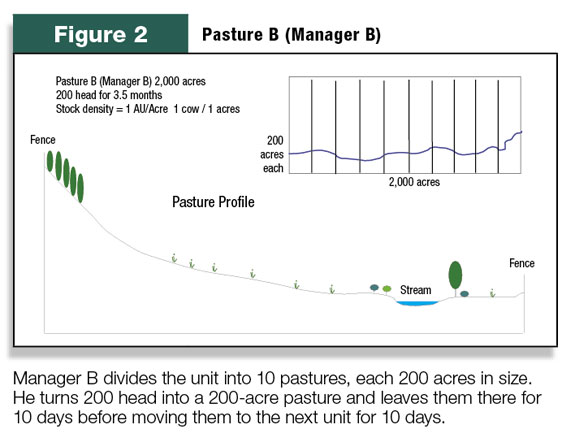
Manager B grazing plan
- 2,000 acres, 200 cows, 10 pastures, each 200 acres
- Stocked at 3 acres/AUM
- Stock density = 200/200 = 1.0 AU/acre, i.e. each cow has 1 acre
- Grazing period is 10 days for each pasture, or 3.5 months for 10 pastures
Note: The “stocking rates” used by each manager are identical (3 acres per AUM).
Consider potential livestock distribution patterns and forage use in these diagrams.
Manager A turns 200 head into a 2,000-acre pasture and leaves them there for 3.5 months (100 days).
Manager B divides the unit into 10 pastures, each 200 acres in size. He turns 200 head into a 200-acre pasture and leaves them there for 10 days before moving them to the next unit for 10 days.
Let’s examine how forage plants respond to these two contrasting grazing scenarios.
Assume that three major forage plants are present:
- Species A: highly palatable, preferred by livestock (e.g. green needlegrass)
- Species B: palatable, moderately preferred by livestock (e.g. bluebunch wheatgrass)
- Species C: moderately palatable, not preferred by livestock (e.g. Idaho fescue)
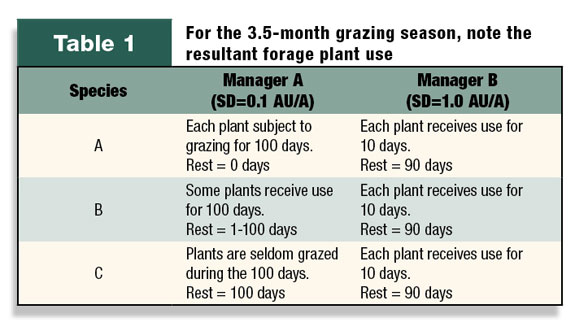
For the 3.5-month grazing season, note the resultant forage plant use (see Table 1.)
Consequence: With Manager A, the least-preferred plants get the most rest; the most-preferred and most valuable plants get the least rest.
With Manager B, all plants receive the same exposure to grazing and the same amount of rest.
Questions to consider for these contrasting scenarios over a period of years:
- What are the consequences to forage plants, soils and riparian areas of reducing grazing periods from 100 days to 10 days per grazing season?
- Which forage plants will be grazed? Which forage plants will not be grazed?
- Where will the cattle graze? Where will they loiter?
- How will the soils and the riparian zone be affected?
- How will range condition be affected?
- What other conditions will be altered, such as water quality, wildlife habitat, weed infestations, etc.?
While this is a simplistic example, it illustrates some of the responses to using stock density as a management tool.
Conclusions
Stock density is a valuable tool in grazing management because it will achieve the following when used properly:
- Alter livestock feeding behavior and forage preferences, allowing greater harvest efficiency and higher range carrying capacity
- Improve the distribution of livestock within a grazing unit, further increasing carrying capacity
- Provide shorter grazing periods and longer rest periods, thus improving health of vegetation
- Improve soil functions and nutrient cycling through the concentration of dung and urine and impact of animal hooves
- Facilitate movement of livestock by reducing the size of individual grazing units
As with any management tool, stock density requires training and experience to apply properly. At very high stock densities (e.g. more than 10 AUs/A), forage can disappear quickly and animals may be stressed, particularly if the forage supply runs short.
Length of grazing periods must be watched carefully so that the forage resource is not overutilized before livestock are moved.
What are the costs to management associated with use of higher stock densities? Additional fencing is typically needed and additional livestock moves are necessary.
Fortunately, the advent of excellent electric fencing systems makes effective, low-cost pasture subdivision a reality.
Livestock enjoy moving onto fresh forage and moves are generally easily managed. The payoff is improved range carrying capacity and improved land health.
Dramatically increasing stock density is not always practical or appropriate in every ranching situation.
However, even relatively modest increases in stock density can be readily achieved and will yield noticeable responses in animal behavior, greater production and land health improvement. ![]()
PHOTOS
TOP: In traditional grazing systems, stock density is quite low, allowing livestock to be highly selective in their forage selection.
MIDDLE: This grazing unit is stocked at 30 pairs per acre. Yet it is obvious that the cattle aren’t packed shoulder to shoulder.
BOTTOM: Bison characteristically graze and move at high stock densities. On this Montana ranch, the 2,500-plus herd often moved up to 8 miles in a day within 5-acre to 15,000-acre territories. Photos courtesy of Brian Sindelar.








